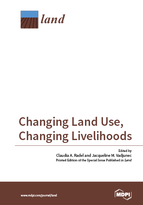Changing Land Use, Changing Livelihoods
A special issue of Land (ISSN 2073-445X).
Deadline for manuscript submissions: closed (31 July 2015) | Viewed by 106513
Special Issue Editors
Interests: gender and agrarian change, conservation, and natural resource management & assets; migration and land-use change; smallholder livelihood dynamics
Special Issues, Collections and Topics in MDPI journals
Interests: human dimensions of global environmental change; common property theory; resource management; cultural and political ecology; mixed and participatory research methods
Special Issues, Collections and Topics in MDPI journals
Special Issue Information
Dear Colleagues,
Understanding changes in rural smallholder livelihoods has long been considered essential to comprehending some types of land use changes. Nonetheless, contemporary changes in smallholder livelihood strategies have not often been fore-fronted in more recent land use change studies. Nor have understandings of household livelihood change, especially at the household scale, always been linked well to regional patterns of land use change. Calls to seek complementarities between the approaches, methods, and frameworks found within land change science (LCS) and political ecology (PE) demonstrate, in part, a desire to highlight the role of changing livelihoods in changing land systems. Fore-fronting changing livelihoods and livelihood strategies also links to the emerging foci on networks; teleconnections; and household politics, production, and adaptation in land change studies. Other scholars have recently argued for conceptualizing livelihoods and landscapes as co-produced.
For this special issue, we are interested in contributions that link changing livelihood strategies to changing land uses, through either empirical research or conceptual/theoretical works, examining any key processes, including but not limited to:
- Smallholder agricultural production and adaptation
- Livelihood vulnerability and resilience
- Labor migration and remittances
- Social relations of inequality and/or difference such as gender, race, class, and ethnicity
- Political economy teleconnections
- Rural to urban, transboundary, and multi-scalar linkages
- Network relationships and transformations
Contributions at the intersection of land change science and political ecology are especially welcome, but contributions from other human-environment fields that fore-front smallholder livelihoods are also highly welcome. Regional and scalar diversity in contributions is also desired.
Proposed titles and abstracts (250 words) can be submitted by 30 April 2015 to the guest editors, at [email protected], for possible feedback, if prospective authors want some feedback before preparing their manuscripts.
Article Publication Fees of quality submissions could have a chance to be waived.
Dr. Claudia A. Radel
Dr. Jacqueline M. Vadjunec
Guest Editors
Manuscript Submission Information
Manuscripts should be submitted online at www.mdpi.com by registering and logging in to this website. Once you are registered, click here to go to the submission form. Manuscripts can be submitted until the deadline. All submissions that pass pre-check are peer-reviewed. Accepted papers will be published continuously in the journal (as soon as accepted) and will be listed together on the special issue website. Research articles, review articles as well as short communications are invited. For planned papers, a title and short abstract (about 100 words) can be sent to the Editorial Office for announcement on this website.
Submitted manuscripts should not have been published previously, nor be under consideration for publication elsewhere (except conference proceedings papers). All manuscripts are thoroughly refereed through a single-blind peer-review process. A guide for authors and other relevant information for submission of manuscripts is available on the Instructions for Authors page. Land is an international peer-reviewed open access monthly journal published by MDPI.
Please visit the Instructions for Authors page before submitting a manuscript. The Article Processing Charge (APC) for publication in this open access journal is 2600 CHF (Swiss Francs). Submitted papers should be well formatted and use good English. Authors may use MDPI's English editing service prior to publication or during author revisions.
Keywords
- adaptation
- households
- livelihoods
- networks
- remittances
- resilience
- social inequality/difference
- teleconnections
- vulnerability







